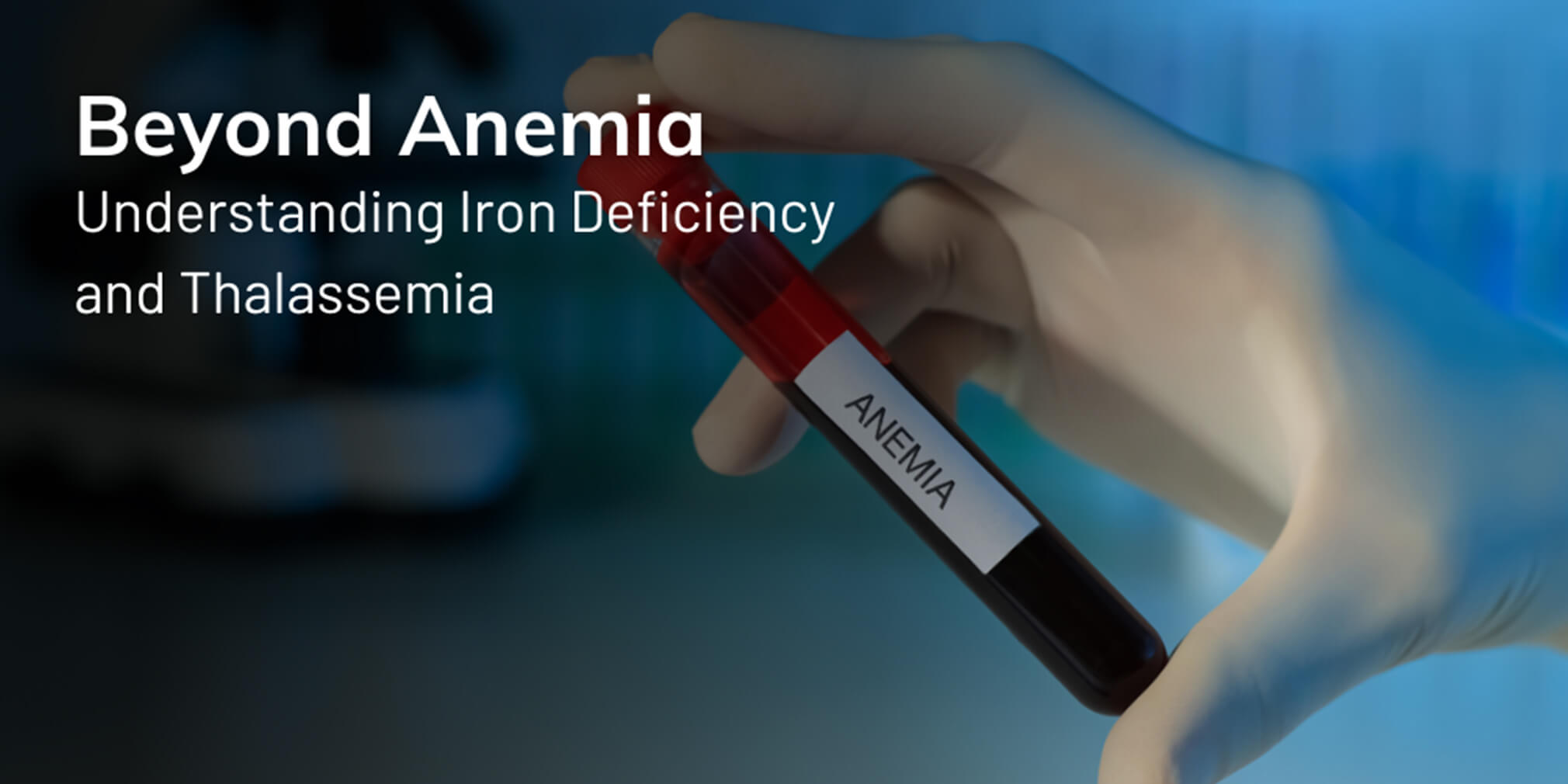
Beyond Anemia: Understanding Iron Deficiency and Thalassemia
Defects in the blood, particularly stemming from low levels of iron, can cause numerous health issues in people. Thalassemia is a genetic disorder that interferes with the human body’s ability to produce normal hemoglobin (the protein in red blood cells that carries oxygen).
As a consequence, individuals with Thalassemia symptoms usually have fewer functional red blood cells and reduced hemoglobin levels. It leads to iron deficiency (anemia), and the symptoms are as follows:
- Persistent Fatigue (Tiredness).
- Physical Weakness.
- Respiratory Problems.
This condition is commonly found in regions where malaria has been widespread historically. Individuals or carriers with only one copy of the mutated gene often have minimal or no symptoms. However, they can pass the condition genetically to their offspring (children). This raises an essential question:
Who is at a higher risk of Thalassemia and why?
We need to understand the symptoms of iron deficiency to understand the likelihood of Thalassemia’s development. We need to examine the genetic mutations that cause it. If a person is born with this condition, it is passed down to them from their parents through specific mutations in genes that control the production of hemoglobin.
The Genes behind Thalassemia – what are they?
Thalassemia takes place when the genes that produce the globin chains making up hemoglobin are either deleted or mutated. Thus, hemoglobin is made of two types of protein chains: alpha and beta.
Alpha Thalassemia occurs from mutations in the HBA1 and HBA2 genes. They affect the production of alpha-globin. Beta Thalassemia is caused by mutations in the HBB gene, which disrupts beta-globin production.
Everyone inherits two copies of the gene, i.e., one from each parent. The severity of thalassemia depends on the number of gene copies affected and whether the mutation reduces or completely stops the production of globin chains.
What symptoms do carriers often experience?
Carriers often experience mild symptoms or none at all. Yet they can still pass the gene on to their offspring. When both parents are carriers, there is a higher probability of having a child with moderate to severe Thalassemia.
Different kinds of Thalassemia
Alpha Thalassemia
Mutations in the HBA1 and HBA2 genes cause Alpha Thalassemia. They encode the alpha-globin subunits of hemoglobin. Four different kinds exist depending on the number of the four alpha-globin genes that are affected:
- Silent Carrier State: One gene gets affected, and affected individuals are usually asymptomatic.
- Alpha Thalassemia Trait: Individuals with this trait have two affected genes and may experience mild anemia.
- Hemoglobin H Disease: This condition affects three genes, and individuals with it may experience moderate to severe anemia, as well as splenomegaly and bone deformities.
- Hydrops Fetalis: In this condition, all four genes are affected. The condition is often fatal either before or shortly after birth.
Beta Thalassemia
Beta Thalassemia is caused by mutations in the HBB gene, which encodes the beta-globin subunits of hemoglobin. Three different kinds are based on the severity of mutations:
- Beta Thalassemia Minor (Trait): One gene gets affected, and affected individuals are usually asymptomatic, or may have mild anemia.
- Beta Thalassemia Intermedia: Both genes are affected, yet the mutations allow for some production of beta-globin. Symptoms range from moderate to severe anemia.
- Beta Thalassemia Major (also known as Cooley’s anemia): Both genes are affected, resulting in little to no production of beta-globin. Symptoms are severe and include retardation of growth, severe anemia, plus skeletal abnormalities.
Diagnosis and Treatment Options of Thalassemia
Lab tests and genetic evaluations require diagnosis of symptoms. Once a symptom or two related to thalassemia is detected, then tests & evaluations confirm and define the type of thalassemia a person is suffering from. Here is a breakdown of the key diagnostic methods to detect the condition:
- Complete Blood Count (CBC).
- DNA analysis/Genetic Testing.
- Hemoglobin Electrophoresis.
- High Performance Liquid Chemotherapy.
- Iron Studies.
- Peripheral Blood Smear.
- Prenatal Testing (either amniocentesis or Chorionic Villus Sampling).
Here are the available treatment options for Thalassemia:
- Blood Transfusions.
- Bone Marrow or Stem Cell Transplantation.
- Folic Acid Supplements.
- Gene Therapy.
- Iron Chelation Therapy.
- Surgical Removal of the Spleen (Splenectomy).
- Supportive Care and Further Monitoring
Understanding both Iron Deficiency and Anemia
Both lack of iron and anemia affect millions worldwide. Almost 30% of women and 40% of children are anemic. The symptoms are either undiagnosed or misunderstood. People should know facts, especially:
- If they are experiencing symptoms or not.
- Supporting loved ones affected.
- Curiosity about whether or not they are affected.
They must understand the distinction between anemia and low iron levels.
Anemia
Anemia occurs when the body lacks sufficient red blood cells or hemoglobin to transport oxygen effectively. Symptoms include fatigue, shortness of breath, weakness, and other effects that can significantly impact a person’s quality of life.
Iron Deficiency
It is one of the most common causes of anemia. Iron is essential for hemoglobin production. Hemoglobin is the oxygen-carrying protein in red blood cells.
Further Understanding comparisons and differences between these two
When a person feels unusually tired or weak, one of the most common causes can be low iron levels. It is a condition in which the human body lacks sufficient iron to produce healthy red blood cells. However, these symptoms can also indicate thalassemia, a genetic blood disorder that affects the body’s production of hemoglobin.
Understanding the difference between anemia and thalassemia is indeed essential. Both can lead to anemia and share similar overlapping symptoms, such as fatigue, paleness, and shortness of breath; however, their underlying causes and treatment methods differ significantly. Iron deficiency anemia is typically acquired through the following factors:
- Inadequate dietary iron intake.
- Blood loss (such as heavy menstrual bleeding or internal bleeding).
- Impaired iron absorption by the human body.
It can be treated through the use of iron supplements and dietary changes. The latter is provided as per instructions of a dietician and a qualified physician.
Now is the time to understand the debate of iron deficiency vs thalassemia. Both have similar symptoms, but the latter is a genetically inherited condition. It is passed down through families. The condition indicates that the body will be unable to produce enough hemoglobin, despite adequate iron levels in the blood.
Individuals with thalassemia can sometimes have an excessive amount of iron in their bodies due to frequent blood transfusions in thalassemia, or increased iron absorption. This is why accurate diagnosis of conditions is crucial. Why? Because treating thalassemia with iron supplements is dangerous.
Proper diagnosis involves specific blood tests that look beyond iron levels in the blood. They examine the characteristics of red blood cells, along with specific genetic indicators, to differentiate between these two distinct causes of anemia.
Treating Iron Deficiency – the methods involved
Correct diagnosis of blood iron levels is helpful. It plays a part in effective iron deficiency treatment. The treatments are available. The primary objective is to restore the body’s iron levels to fix the underlying cause.
Iron supplements are the most common treatment method (usually taken orally). They help replenish iron levels in the human body by generating healthy blood cells. In turn, they reduce symptoms such as fatigue and weakness.
The alternative treatment method to counter deficiency of iron is dietary changes. Incorporating iron-rich foods such as leafy greens, red meat, fortified cereals, and beans can surely help. To improve absorption, they should ideally be consumed with vitamin C.
In the event of significant blood loss, medical treatment and intervention may be necessary to stop the bleeding. In cases where oral supplements are ineffective or the deficiency is severe, doctors may consider intravenous (IV) iron infusions for a faster boost.
Treatments are usually resolved with the correct treatment and post-treatment monitoring. Thalassemia, however, is a genetic condition. Its management requires different methods.
Over to You
Both Iron Deficiency and Thalassemia are distinct medical conditions affecting human blood that share similar symptoms. However, an accurate diagnosis of the medical condition is necessary. Else, the consequences of wrong diagnosis are unimaginable.
If you are unsure about your blood health or are experiencing symptoms related to those mentioned earlier, please do not hesitate to visit a nearby physician or haematologist immediately.
